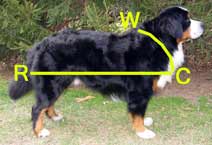Measuring for Carting Equipment
It is extremely important that your dog be carefully measured for the sport of carting. A dog's height, weight, chest to tail length, and collar measurement all play vital roles in selecting and fitting appropriate equipment. Ill-fitting equipment can lead to injury, and will make the carting experience unpleasant for the dog.

Harness Measurement
Never guess at any of the measurements requested for drafting equipment orders.
Withers to Chest/Breast Bone
This is the only measurement needed for a harness.
Be sure your dog is standing straight -- no leaning, slouching or roaching. Measure from the point of the withers (indentation between shoulder blades) where neck and shoulders meet, down one side of the neck, to the point of the breastbone, taking the shortest possible route from point to point. The tape should pass just in front of the shoulder on its way to the point of the breast bone.
Be sure the measuring tape is under the dogs fur, and that the tape is pulled tight. (The key is to measure the dog, not his coat!)
Purpose: This is a critical measurement for fitting the harness. If the harness doesn't fit properly, it will affect the dog's ability to pull.
How to check accuracy: Double check by taking this measurement more than one time. Also measure on the opposite side -- you should come up with the same measurement. Do not round off -- take measurements to within 1/4 inch.
Height at Withers
This is a straight line measurement from the floor to a point parallel with the dog's withers. The measuring tape should not touch the dog when taking this measurement. Be sure your dog is standing straight -- no leaning, slouching or roaching.
Purpose: This measurement will help determine what size wheels your cart or wagon should have. It is also critical for determining the angle and curve of bent wood shafts.
How to check accuracy: Double check by taking this measurement more than one time.
Chest to Rear
This is a straight line measurement from a point parallel to your dog's breast bone to a point parallel to the back of his thighs. The measuring tape should not touch the dog when taking this measurement. Be sure your dog is standing straight -- no leaning, slouching or roaching.
Purpose: This measurement will help ensure that shaft length is appropriate for your dog. If shafts are too short, the dog will be bumped by equipment.
How to check accuracy: Double check by taking this measurement more than one time.
Questions?
CONTACT US if you have any questions about these measurements, or if you need additional guidance!
